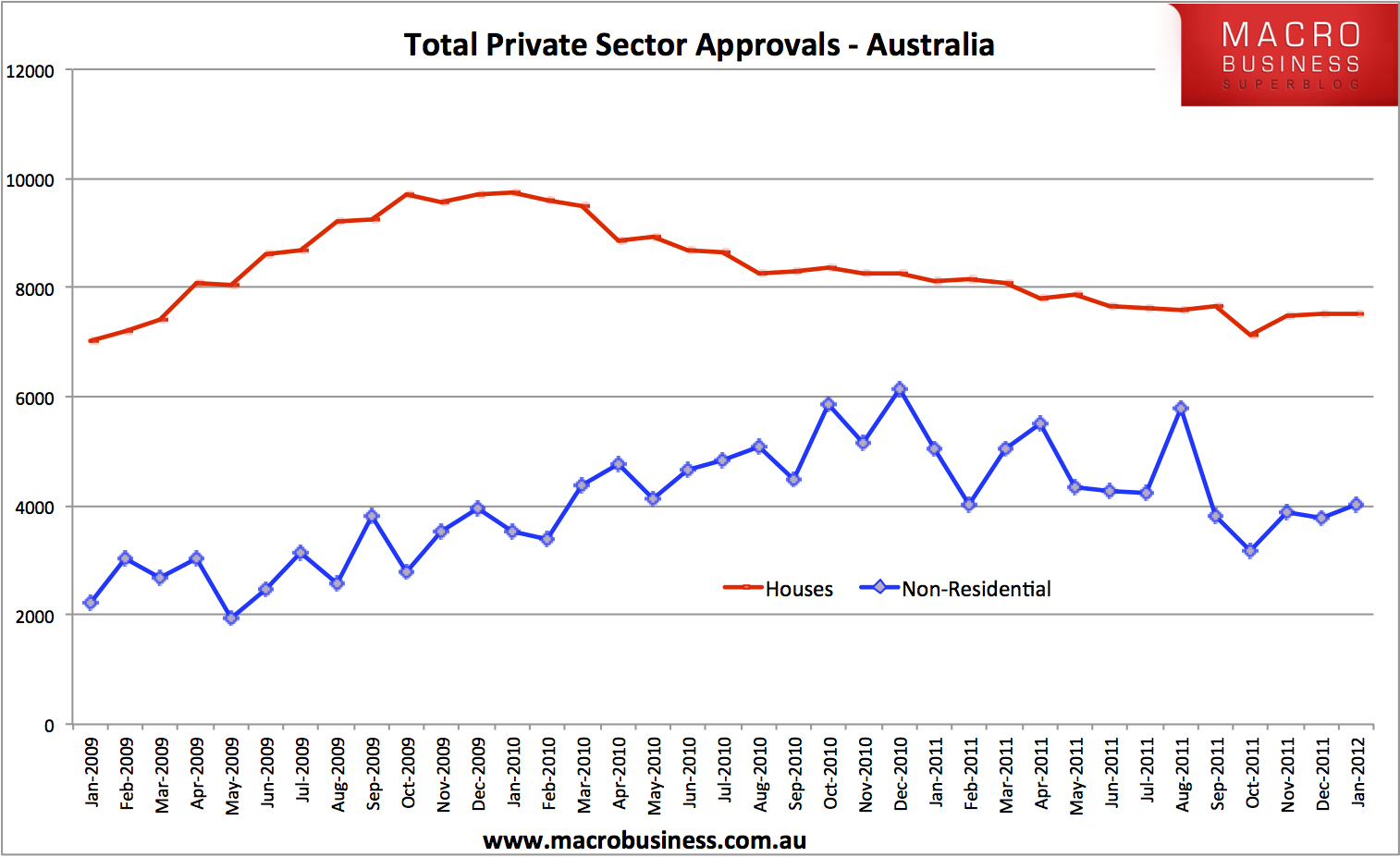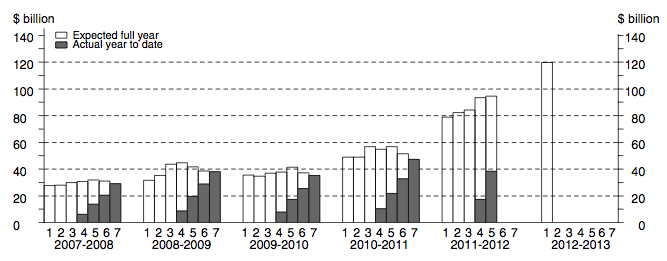
Data is the life blood of any economic watcher. Without it we are naked, bereft of meaning. But like life, some days it’s a torrent! Last night I was asleep before my head hit the pillow, exhausted from an extraordinary day of economic data that shook up many presumptions but ultimately left my overall sense of the economy unchanged.
Here’s a quick recap of the data:
- the Fed pushed out QE3 on upgrades to Dec QTR US growth
- the ECB rolled out LTRO II with half a trillion euros to 800 banks
- the local manufacturing PMI expanded
- capex came in below expectations but still very strong. It foreshadowed huge mining investment into next financial year
- building approvals came in very soft again
- R.P.Data house prices rose 0.8% in February although it’s shift to a daily methodology leaves me with questions
- AFG released February mortgage data suggesting a low level recovery
- RateCity released a study showing loosening conditions for mortgage approvals
So, where on earth does all of that leave us?
First, globally, there’s a difference between easy money and easy growth. I do not see a great deal of change for Europe from its current recessionary conditions driven by austerity and a raging credit crunch in the periphery. I still expect, as well, a slowdown in the US recovery as the recent inventory cycle dissipates. The type of landing in the offing in China remains a big unknown and risk with recent data showing both stability and deterioration. So, in terms of the prospects for global economic growth the picture is still fogged with risks.
This context of growth and risk will effect the Australian economy in different ways. Probably the most important is that commodity prices are unlikely to recover from their year end swoon much beyond current levels because QE3 no longer offers traders an easy buck on the monetary inflation of real assets. Second, and equally significant, the ECB’s LTRO II will build on the loosening of global credit markets that has transpired since the New Year. It is not necessarily the case that some of those new euros will be coming to Australia but general conditions in credit markets are now making it cheaper for our banks to issue new debt. European banks have begun to issue unsecured bonds for the first time in many months and Westpac is marketing an issuance of unsecured “samurai bonds” as I write. In short, bank funding costs are now falling. Bank CDS prices have fallen consistently:

Things have also improved a little for the banks on the asset side of their balance sheets. Through a combination of rate cuts and easing loan conditions (that is, they’ll lend you more on a smaller deposit), housing credit is flowing a little better. There is some ongoing strength in NSW following the first home buyer rush of late last year on the removal of stamp duty exemptions. This is probably the second round effects of those that sold moving up. The give back as FHBs withdraw from the market again will probably see this peter out.
In QLD, WA and VIC there are also small recoveries of mortgage issuance but at very low levels. The 0.8% increase in R.P. Data’s house prices for February was a methodological shift that jumped over very soft January numbers. Moreover, it was driven by a 1.84% rise in Melbourne prices which was contradicted by leading indicator mortgage issuance data offered by AFG. It will probably wash out of the figures as the daily index processes new data.
Still, it is worth noting that these nascent improvements in mortgage credit have transpired despite the inclement conditions of very public job losses and bank rate rises. There may be more latent housing demand than I thought just one month ago. Yet, it is still a brave soul calling out a return to house price growth, not least because the RBA will not allow it.
Retail too remains subdued. There is no evidence of any broad bounce in spending beyond an early New Year splurge on the dining out category that drove all of the growth in the index. It seems Australians have, for the time being, taken on the habits of Generation Y. We’re prepared to scrimp and scrape on clothes and household items but we can’t give up the coffee or Thai takeout!

Still, there is a very strong correlation between the value of homes and retail spending and if we see nominal house prices stabilise through a new pulse of lending, we may see retail numbers improve.
Neither did the good news extend to the business of new houses. ABS and HIA figures this week for new purchases and approvals were both terrible. Dwelling construction is headed into a difficult period, especially in Melbourne where a huge four year building boom has created oversupply. Yet, there is not likely to be any move to rescue it. Both monetary and fiscal authorities have been firm that they need to free up economic resources for the growth of mining, and who better than existing builders?

Which brings us to the good news released yesterday by the ABS: capital expenditure numbers that are off the chart, driven almost entirely by mining. The projections for next year’s investment were colossal. The downside, of course, is that every other sector is planning on shrinking its capital investment. It’s a very bad idea to let such an imbalance continue, putting all the eggs in one basket as it were, but that’s a story for another day. Today, at least, we can marvel at the growth in our isolated north.

Another bright spot for the economy was a second month of growth for the nation’s manufacturing sector. The growth was driven by some feed through of the mining boom to sectors like transport components. Counter intuitively, a big jump in export orders also contributed suggesting to the optimistic that manufacturers are adapting to a higher dollar.

Which brings us, finally, to interest rates. There was no data this week to suggest any imminent further interest rate cuts. Indeed, the RBA has us right where it wants us: rational and restrained.

